At Access Rehabilitation Equipment, we commit to providing you and your loved ones solutions for life! Fitting your lifestyle, each aid and equipment is tailored to the unique challenges you are facing, so work with us to find the independence and mobility you want!
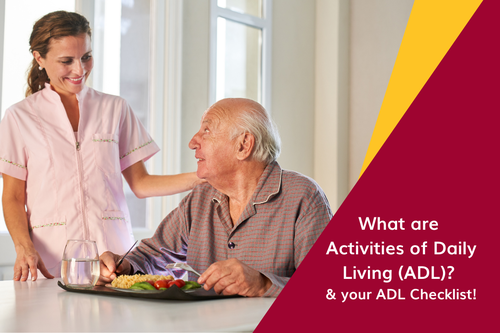
Introduction
Activities of Daily Living (ADLs) are the basic self-care tasks that we all need to do every day to stay safe, healthy, clean, and feel good about ourselves.
From eating to grooming and using the toilet, most of us perform these routine activities daily without any assistance. However, for someone with a physical disability or learning difficulty, these simple activities of daily living can become significant challenges and can impact their functional and independent living skills.
If you've noticed your loved one struggling to accomplish these key life tasks, it could be a sign that they need a major change in care. To make a well-informed decision about the type of care your loved one requires, keep reading to learn more about these important terms and related skills. You'll also find a checklist for ADLs that can help you in assessing your client or loved one's current condition and needs.
What does ADL mean in medical terms?
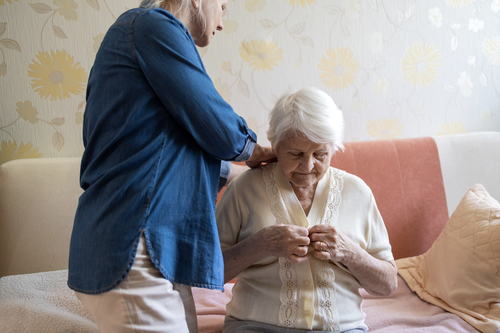
In medical terms, "ADL" refers to Activities of Daily Living - the basic tasks that individuals need to perform every day in order to live a healthy, independent life. ADLs are the fundamental self-care skills required to get through a day safely and with dignity.
A person's ability to complete ADLs is an important measure of their functional status and need for assistance. Difficulties with ADLs can arise from physical or cognitive limitations due to aging, injury, illness or disability. Assessing ADLs helps healthcare providers determine the right level of care or support services.
So what exactly are considered ADL tasks? The core areas include:
- Eating: The ability to feed oneself food and beverages, including cutting food and bringing it to the mouth, chewing and swallowing without difficulty.
- Dressing: Being able to pick out appropriate clothes for the weather and occasion and being able to dress and undress, including handling buttons, zippers and laces.
- Personal Hygiene: Completing grooming activities like brushing teeth, bathing, washing hair, and nail care.
- Toileting: Getting to and from the toilet, using it appropriately, and maintaining personal hygiene and cleanliness related to bladder and bowel functions.
- Functional Mobility: Safely moving around as needed for daily routines, such as getting in and out of bed, standing up from a seated position, and walking.
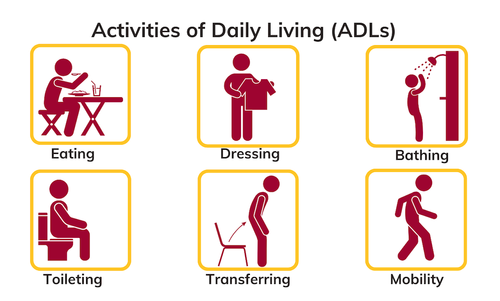
What’s the difference between ADLs and IADLs?
When assessing an individual's ability to live independently, healthcare professionals look at two main categories of activities - Activities of Daily Living (ADLs) and Instrumental Activities of Daily Living (IADLs). Understanding the difference between these two sets of skills is important for determining the right level of care and support.
While ADLs are the most basic abilities, IADLs require a higher level of cognitive and physical capability. IADLs incorporate more complex tasks such as managing finances, paying bills, grocery shopping, meal preparation, and taking prescribed medications.
Accomplishing IADLs demands abilities like planning, prioritizing, problem-solving, and memory skills. They allow an individual not only to function but also to thrive independently within their communities.
What are some examples of Instrumental Activities of Daily Living? (IADLs)

While not necessary for functional living, the ability to perform IADLs can significantly improve the quality of life. Examples of IADLs include:
- Transportation and Shopping: Ability to get groceries, run errands, attend appointments/events by either driving yourself or making transportation arrangements.
- Managing Finances: Handling tasks like paying bills on time and keeping track of financial accounts and assets.
- Meal Preparation and Shopping: Involves everything required to get a meal on the table. It also covers shopping for essential items for daily life, including clothing and other necessities.
- Housekeeping and Home Maintenance: Abilities like cleaning up after meals, keeping living areas reasonably tidy, and doing basic home maintenance and repairs.
- Communication: Being able to use phones, write letters/emails, and keep up with incoming calls, messages and mail.
- Medication Management: Having the capacity to obtain prescriptions and taking medications correctly by following dosage instructions.
Why is it important to assess ADLs and IADLs?
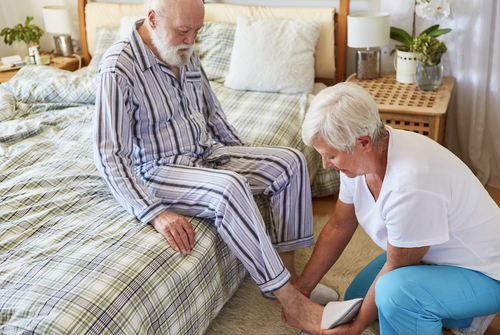
Assessing an individual's ability to perform ADLs and IADLs is a crucial step in determining their level of independence and developing an appropriate care plan. These evaluations provide valuable insights into the person's functional status and flag any areas where assistance may be required. Periodic assessments can monitor changes over time, allowing care plans to be adjusted as needed.
By understanding their specific ADL limitations, such as difficulties with bathing or dressing, potential safety risks can be identified and addressed. IADL assessments evaluate more complex skills - struggles here could indicate early cognitive decline.
Overall, these assessments guide recommendations for supportive equipment, home modifications, personal care services, or assisted living to maximize independence and quality of life. As the ability to complete ADLs and IADLs impacts dignity and self-esteem, proper assessment ensures the right care is provided at the appropriate level.
Can ADL skills be improved?
The good news is, with the right help, there are often ways for rehabilitating or compensating for ADL difficulties.
The Role of Rehabilitation Therapies
Depending on what is causing the problems with ADLs, different therapists may be able to help:
- Physical Therapy - If injuries, strokes, or mobility issues make ADLs hard, physical therapists can provide exercises to build up strength, balance, and movement abilities needed for essential tasks.
- Occupational Therapy - Occupational therapists focus on increasing independence with ADLs by simplifying the tasks, providing equipment aids, and modifying the home to make it more accessible.
- Speech Therapy - For people struggling to swallow foods/liquids safely, speech therapists can address these needs.
The Importance of the Care Partner
While therapists are very helpful, the daily assistance of caregivers is vital for keeping up any ADL improvements made in therapy sessions. Caregivers can:
- Encourage practicing - Instead of doing tasks for the person, letting them keep trying to do ADL skills helps reinforce their abilities.
- Use adaptive equipment - Tools like grab bars, elevated toilet seats, and dressing aids help compensate for ADL limitations.
- Simplify steps - Breaking down more complex ADLs into achievable steps makes them more manageable.
- Modify environment - Minimizing hazards and creating an accessible living space promotes safer, easier ADL performance.
Caregivers need training on how to best support and continue the therapy strategies at home. With patience and the right assistance, many can experience ADL improvement over time.
While some ADL losses may be permanent, maximizing independence through a team approach of skilled rehabilitation services alongside supportive caregivers can often allow individuals to regain and maintain their highest level of self-care abilities.
Click Here to Download Your Free Printable Activities of Daily Living - ADL and IADL Checklist
FAQs
Is doing laundry an ADL or IADL?
Doing laundry involves several steps beyond basic self-care, such as sorting clothes, loading and unloading the washing machine, choosing appropriate detergents, operating the machine, and folding or hanging clothes. These tasks require more complex cognitive and physical skills, making laundry an IADL.
Is vacuuming an ADL?
Vacuuming is not typically considered an ADL as it does not involve personal care activities essential for survival and well-being. Like laundry, vacuuming requires a higher level of cognitive and physical ability because it involves operating equipment, moving furniture if necessary, and navigating around obstacles, classifying it as an IADL.
Conclusion
Regular assessments of ADLs can help detect any unnoticed symptoms early and ensure prompt treatment for a better prognosis. If you or your loved ones need assistance with Activities of Daily Living (ADLs), don't hesitate to seek help. Caregivers and assisted living facilities can greatly enhance your well-being by offering support, encouragement, monitoring progress, providing timely assistance, and helping you maintain independence.
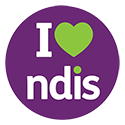

 Providing solutions for life
Providing solutions for life







